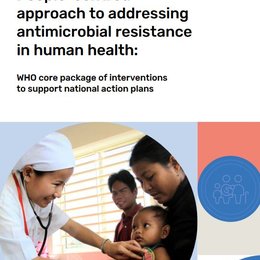
Oct. 23, 2023
Global
Engaging and empowering people and communities, Strengthening governance and accountability, Reorienting the model of care, Coordinating services within and across sectors, Creating an enabling environment
People-centred approach to addressing antimicrobial resistance in human health
This document outlines the concept and content of the WHO people-centred approach to addressing antimicrobial resistance (AMR) in the human health sector. The proposed approach recognizes and aims to address the challenges and health system barriers people face when accessing health services to prevent, diagnose and treat (drug-resistant) infections. It puts people and their needs at the centre of the AMR response and guides policy-makers in taking programmatic and comprehensive actions to mitigate AMR in line with a proposed package of core interventions. These interventions are based on a review of four pillars and two foundational steps that are critical to overcome barriers faced by people and health systems in addressing AMR. The four pillars are: (1) prevention of infections; (2) access to essential health services; (3) timely, accurate diagnosis; and (4) appropriate, quality-assured treatment. The pillars are supported by the two foundational steps: effective governance, awareness and education; and strategic information through surveillance and research. Building and adding on to the objectives of the Global action plan on AMR, the 13 core interventions and accompanying priority actions are designed to address AMR in a programmatic manner that puts people, their needs and equitable access to health services at the centre of the AMR response in the community, in primary care, secondary and tertiary care, and at national and/or subnational level.
The development of the people-centred core package of AMR interventions was based on a review of the evidence and multidisciplinary expert opinion, complemented with feedback from a global online consultation and WHO’s strategic and technical advisory group on antimicrobial resistance. As countries develop or revise their national action plans (NAPs) on AMR, the people-centred core package of interventions can support the design and prioritization of actions in the human health sector at the different levels of implementation and integrated with broader health system strengthening and pandemic preparedness and response plans.
- Source: